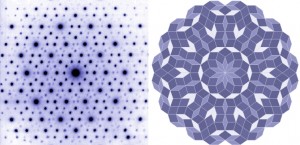The Nobel prize for chemistry has been awarded to Daniel Shechtman, from Technion – the Israel Institute of Technology in Haifa, for his discovery of the structure of quasicrystals. Until 1982, it was thought that only two-, three-, four- or six-fold rotational symmetry were possible, however Dr. Schechtman’s discovery changed all that when his electron diffraction studies of an Al-Mn alloy crystallised from the melt showed “five-fold symmetry”. Since pentagons don’t tessellate, two or more shapes are necessary to form a close packed structure. Thus, although invented long before they were discovered, 3D-Penrose tiling can be used very effectively to describe the diffraction pattern from the Al-Mn quasicrystal by putting atoms at the vertices and calculating the Fourier Transform. Since 1982, dozens of other quasicrystals have been discovered and a new and beautiful branch of structural science was born. Links:
Since the first Nobel Prize for Physics was awarded in 1901 to Wilhelm Conrad Röntgen for the discovery of X-rays, advances in (or key to) structural science have been recognised many times, including:
- Venkatraman Ramakrishnan, Thomas A. Steitz and Ada E. Yonath “for studies of the structure and function of the ribosome” (Chemistry, 2009)
- Walter Kohn “for his development of the density-functional theory” and John A. Pople “for his development of computational methods in quantum chemistry” (Chemistry, 1998)
- Robert F. Curl Jr., Sir Harold W. Kroto and Richard E. Smalley “for their discovery of fullerenes” (Chemistry, 1996)
- Herbert A. Hauptman and Jerome Karle “for their outstanding achievements in the development of direct methods for the determination of crystal structures” (Chemistry, 1985)
- Dorothy Crowfoot Hodgkin “for her determinations by X-ray techniques of the structures of important biochemical substances” (Chemistry, 1964)
- Max Ferdinand Perutz and John Cowdery Kendrew “for their studies of the structures of globular proteins” (Chemistry, 1962)
- Francis Harry Compton Crick, James Dewey Watson and Maurice Hugh Frederick Wilkins “for their discoveries concerning the molecular structure of nucleic acids and its significance for information transfer in living material” (Medicine, 1962)
- Linus Pauling “for his research into the nature of the chemical bond and its application to the elucidation of the structure of complex substances” (Chemistry, 1954)
- Petrus (Peter) Josephus Wilhelmus Debye “for his contributions to our knowledge of molecular structure through his investigations on dipole moments and on the diffraction of X-rays and electrons in gases” (Chemistry, 1936)
- James Chadwick “for the discovery of the neutron” (Physics, 1935)
- Prince Louis-Victor Pierre Raymond de Broglie “for his discovery of the wave nature of electrons” (Physics, 1929)
- Niels Henrik David Bohr “for his services in the investigation of the structure of atoms and of the radiation emanating from them” (Physics, 1922)
- Sir William Henry Bragg and William Lawrence Bragg “for their services in the analysis of crystal structure by means of X-rays” (Physics, 1915)
- Max von Laue “for his discovery of the diffraction of X-rays by crystals” (Physics, 1914)
- Marie Curie, nĂ©e Sklodowska “in recognition of her services to the advancement of chemistry by the discovery of the elements radium and polonium, by the isolation of radium and the study of the nature and compounds of this remarkable element” (Chemistry, 1911)
- Ernest Rutherford “for his investigations into the disintegration of the elements, and the chemistry of radioactive substances” (Chemistry, 1908)
- Antoine Henri Becquerel “in recognition of the extraordinary services he has rendered by his discovery of spontaneous radioactivity”, with Pierre Curie and Marie Curie, nĂ©e Sklodowska “in recognition of the extraordinary services they have rendered by their joint researches on the radiation phenomena discovered by Professor Henri Becquerel” (Physics, 1903)
- Hendrik Antoon Lorentz and Pieter Zeeman “in recognition of the extraordinary service they rendered by their researches into the influence of magnetism upon radiation phenomena” (Physics, 1902)
- Wilhelm Conrad Röntgen “in recognition of the extraordinary services he has rendered by the discovery of the remarkable rays subsequently named after him” (Physics, 1901)
